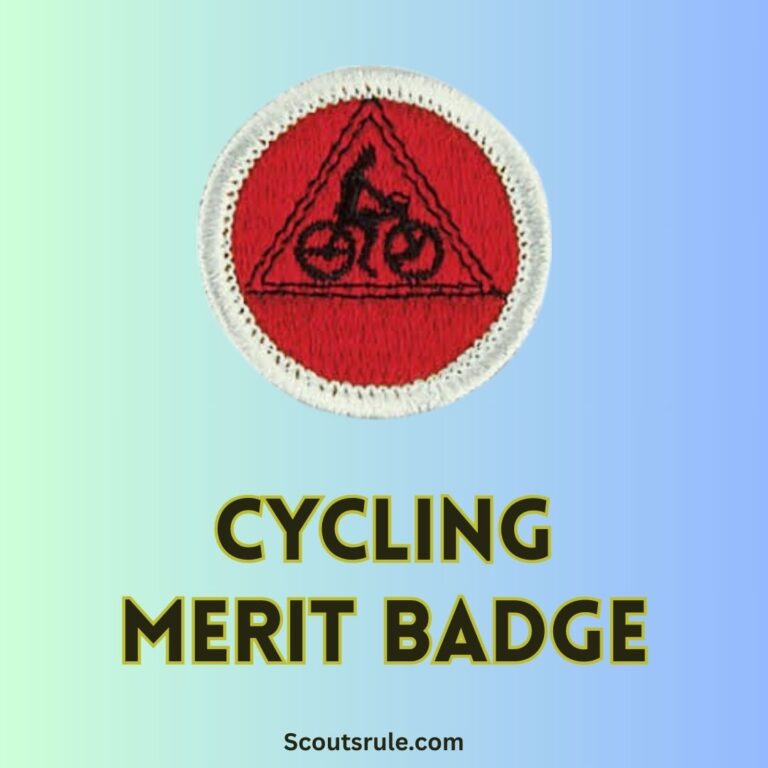
This guide will help you understand every facet of the badge—from safety and preparation to the hands-on skills required to participate in water skiing, wakeboarding, and other aquatic activities. Whether you’re looking to become proficient in water sports or simply wish to better understand the techniques and safety protocols for enjoying the water responsibly, this guide is your roadmap to success.
Post Contents
- Introduction: Embracing the Water
- 2. Badge Objectives and Overview
- 3. Prerequisites and the Importance of Swimming Skills
- 4. Understanding Safety in Water Sports
- 5. Life Jackets: Selection, Fitting, and Importance
- 6. The Water Sports Safety Code
- 7. The Swimmer Test: A Critical Prerequisite
- 8. On-the-Water Requirements and Techniques
- 9. Buddy System and Teamwork in Water Sports
- 10. Equipment, First Aid, and Emergency Preparedness
- 11. Environmental Awareness and Respect on the Water
- Conclusion
Introduction: Embracing the Water
Water sports offer an exciting way to connect with nature, challenge your physical capabilities, and embrace a spirit of adventure on the open water. The Water Sports Merit Badge is designed for Scouts who wish to explore various activities—such as waterskiing, wakeboarding, tubing, and other aquatic pursuits—with a strong emphasis on safety, skill, and responsible behavior.
Whether you dream of gracefully descending down a wake or want to master the techniques needed to stay afloat and in control, this merit badge will equip you with the knowledge and practical experience to meet those goals. By learning these skills, you not only enhance your personal abilities but also reinforce the core values of preparedness, teamwork, and respect for the environment.
2. Badge Objectives and Overview
The primary objectives of the Water Sports Merit Badge include:
- Safety Awareness: Learning to identify hazards associated with water sports and understanding the necessary preventive, responsive, and first-aid measures.
- Proficiency with Safety Equipment: Demonstrating how to properly select, fit, and use life jackets and other personal protective equipment (PPE) essential for water-based activities.
- Understanding and Adhering to the Safety Code: Reviewing the Water Sports Safety Code, discussing it with your counselor, and committing to live by its principles.
- Demonstration of Swimming Competency: Successfully completing the BSA swimmer test to ensure competency in the water.
- Practical Application: Showing on-water skills (waterskiing, wakeboarding, or using a wakeboard) including safe water entry, maneuvering through wakes, executing proper signals, and controlling the boat.
- Teamwork and Communication: Emphasizing the buddy system and effective communication while on the water.
- Equipment Checks and First Aid: Understanding the importance of pre-activity equipment checks and knowing basic first aid for injuries related to water sports.
Overall, the badge seeks to prepare you not only for recreational success but to instill habits that ensure personal safety and environmental respect while enjoying aquatic adventures.
3. Prerequisites and the Importance of Swimming Skills
Before beginning work on the Water Sports Merit Badge, you must have a solid foundation in swimming. Specifically, you are required to successfully complete the BSA swimmer test. This test ensures that you are capable of handling yourself in the water under various conditions.
The Swimmer Test
The swimmer test typically requires you to:
- Jump feet-first into water over your head in sufficient depth.
- Level off and swim 75 yards continuously using a strong stroke such as sidestroke, breaststroke, trudgen, or crawl.
- Immediately follow with an easy, resting backstroke for an additional 25 yards.
- Complete the entire 100 yards in one continuous swim (with at least one sharp turn) without stopping.
- Follow the swim with a rest period by floating.
This test is crucial as water sports, by their nature, demand not only athletic longevity but also the ability to respond to unexpected challenges like falling off or encountering surges. If you haven’t yet earned the Swimming Merit Badge or need additional practice, consider enrolling in local swimming lessons or practicing under the supervision of a skilled swim instructor before advancing.
4. Understanding Safety in Water Sports
Safety is the most critical element of water sports. Before you even set foot on a boat or water ski, you must have a comprehensive understanding of the potential hazards and safety protocols to mitigate them.
4.1 Identifying Hazards and Preventive Measures
Water sports present several unique hazards:
- Environmental Conditions: Unpredictable weather, strong winds, and sudden temperature changes can lead to cold-water shock or hypothermia. Always check local weather conditions before your outing.
- Physical Injuries: Common injuries in water sports include blisters from friction, sprains and strains caused by sudden maneuvers, and, more seriously, concussions or spinal injuries from falls or collisions. For each, you must learn the symptoms and basic first aid.
- Equipment Malfunctions: Failing to check your equipment—especially safety gear like life jackets—can be dangerous. Regular maintenance and pre-activity equipment inspections are essential.
- Water Hazards: Rapid currents, unexpected waves, or obstacles in the water (like rocks or buoys) require constant vigilance. Knowledge of local water conditions and understanding how to navigate hazards can prevent dangerous situations.
4.2 BSA Safety Afloat Policy
An integral part of your training is to review the BSA Safety Afloat policy. This policy establishes uniform guidelines designed for Scouts engaging in water sports. Key points include:
- Pre-Water Checklists: A checklist must be completed before any water activity begins. This covers aspects such as ensuring all life jackets are properly fitted, confirming that the boat is sound, and letting an adult or responsible party know your float plan.
- Emergency Protocols: Understand the procedures if something goes wrong—whether it’s an equipment malfunction, a sudden change in weather, or a medical emergency.
- Communication Measures: Clear communication with your buddy and the boat operator is critical. You should be able to identify and use safety signals, as discussed in the next section.
5. Life Jackets: Selection, Fitting, and Importance
A life jacket (or personal flotation device, PFD) is the single most important piece of safety equipment in water sports. You must be able to explain the characteristics of a life jacket that make it suitable for water sports like waterskiing or wakeboarding.
Characteristics of a Good Life Jacket:
- Fit and Comfort: A properly fitted life jacket should be snug without being overly tight, allowing full range of motion while ensuring buoyancy.
- Buoyancy: It must have adequate buoyancy to keep your head above water in case of an accidental fall. Life jackets rated specifically for water sports are designed to support dynamic movements.
- Durability and Materials: Consider the materials used; some are water-resistant and resistant to the wear-and-tear of outdoor activities.
- Design: Additional features might include reflective materials for visibility, side flares for extra buoyancy, and adjustable straps for a customized fit.
Demonstrating Life Jacket Fitting
Your counselor will require you to show that you know how to choose and correctly fit a life jacket. This demonstration typically involves:
- Selecting a Life Jacket: Explain the features that make it appropriate for water sports.
- Correct Fitting: Demonstrate how to adjust the straps so that the jacket fits securely.
- Verifying Safety: Check that the jacket allows free breathing and movement, and explain how it will keep you safe if you fall into the water.
Discuss with your counselor the differences between various types of life jackets and why you must always wear one while participating in water sports, irrespective of your swimming ability.
6. The Water Sports Safety Code
The Water Sports Safety Code is a set of guidelines designed by the BSA to ensure the safety of Scouts during water activities. You must review these guidelines with your counselor, promising to comply with them at all times. Key elements include:
- Rules for On-Water Behavior: Always maintain a safe distance from other boats and aquatic activities. Follow the signals given by the boat operator and your buddy.
- Boat Operator Safety: Discuss what safety precautions the boat operator should follow when pulling waterskiers or wakeboarders—including maintaining proper speed, ensuring clear communication, and being vigilant about the water conditions.
- Buddy System: Emphasize that water sports are never a solo activity. Always dive into the water with a buddy for assistance in emergencies.
- Consistency in Safety Practices: Regularly review the safety code before every outing. Understand that these rules are in place to protect everyone involved.
Your commitment to these guidelines is central to the merit badge. Be prepared to reiterate these rules to your counselor and explain how they affect your behavior during all water sports activities.
7. The Swimmer Test: A Critical Prerequisite
Before attempting the on-water activities required for this merit badge, you must successfully complete the BSA swimmer test. This test not only ensures that you are comfortable and capable in the water, but it also verifies that you can handle unexpected conditions during water sports.
Components of the Swimmer Test:
- Safe Entry: Jump feet-first into the water over your head in sufficient depth; this demonstrates your ability to enter the water safely.
- Continuous Swimming: Swim 75 yards continuously using a strong and controlled stroke—whether sidestroke, breaststroke, trudgen, or crawl.
- Resting Technique: Without stopping, swim 25 yards using an easy, resting backstroke.
- Uninterrupted Performance: The entire 100 yards must be completed without stops and should include at least one sharp turn to demonstrate your maneuverability in the water.
- Recovery After Swimming: Once you finish the swim, demonstrate that you can calm yourself by floating and recovering properly.
Successfully completing the swimmer test provides you with the confidence to engage in more advanced water sports and sets the foundation for all subsequent outdoor activities involving water.
8. On-the-Water Requirements and Techniques
After your swimming proficiency is confirmed, you’ll progress to the hands-on water sports portion of the badge. This section involves demonstrating control, technique, and safety while participating in water sports such as waterskiing or wakeboarding.
8.1 Basic Water Entry and Deepwater Start
- Water Entry: You must show how to enter the water safely from a boat without assistance. This includes demonstrating a proper, controlled jump that minimizes the risk of injury.
- Deepwater Start: In deep water, you should be able to perform what is known as a deepwater start. This involves jumping into the water from the boat, settling quickly, and then moving into a position where you can be pulled by the boat—all while remaining stable.
- Wakes and Crossings: When the boat is moving, you may be required to show that you can cross the boat’s wake safely. This means navigating from one side of the wake to the other multiple times without falling.
- Steering and Maneuvering: While being pulled by the boat, demonstrate control by practicing turns, including tacking (turning the boat’s bow through the wind) and jibing (switching from one side of the boat to the other).
- Falling and Safety: Additionally, demonstrate how you can fall safely while avoiding obstacles, using techniques to reduce impact and to quickly regain balance.
8.3 Demonstrating Required Signals and Communication
Part of the on-water skills requirement includes being able to communicate effectively with your boat operator through established signals. Typical skier or boarder signals include:
- “Skier Safe”: Indicating that you are all right.
- “Faster” or “Slower”: Requesting adjustments from the boat operator.
- “Turn” or “Change Direction”: Indicating when you need the boat to maneuver.
- “Back to Dock” or “Cut Motor”: Communicating if you need the boat to return immediately or if there is an emergency that requires the motor to be shut off.
- Other Signals: Be prepared to learn any water sport–specific signals defined by your local council or water sport guidelines.
Practice these signals with your buddy and the boat operator; they are essential for ensuring clear, immediate communication during the activity.
9. Buddy System and Teamwork in Water Sports
Just like most water activities, teamwork is critical when participating in water sports. You must always operate under the buddy system, ensuring that both you and your dive partner or water sports partner:
- Coordinate Before the Session: Outline roles and responsibilities, check each other’s safety gear, and agree on signals and emergency procedures.
- Perform Regular Buddy Checks: Ensure that each partner’s equipment (such as life jackets, helmets, and water sports gear) is secure and in working order.
- Assist in Emergencies: Whether it’s helping to reboard a boat after a fall or performing a rescue maneuver, the buddy system is essential for maintaining safety on the water.
By working closely with your buddy, you foster trust, enhance safety, and build the coordination necessary for effective water sports teamwork.
10. Equipment, First Aid, and Emergency Preparedness
In any water sport, robust equipment and preparedness are crucial to avoid mishaps and to address problems if they occur.
Equipment Checks and Maintenance
- Pre-Activity Inspection: Always conduct a thorough inspection of all equipment. This includes checking the boat, tow rope, bindings on skis or wakeboards, and ensuring that your life jacket is properly worn.
- First Aid Readiness: Familiarize yourself with the basic first aid for common water sports injuries. These might include handling minor cuts and bruises, alleviating sprains or strains, and actions to take if someone suffers from cold-water shock or fatigue.
- Emergency Supplies: Keep a first aid kit, a whistle, a waterproof communication device, and any necessary emergency flotation devices within reach.
Emergency Procedures
- Develop a Clear Emergency Plan: Know the location of local emergency services and have an established float plan that someone on shore is aware of.
- Practice Drills: Run coordinated drills with your buddy, simulating the loss of equipment or a situation where one person falls in unexpectedly. These drills reinforce quick responses and proper procedures.
The more familiar you are with your equipment and emergency protocols, the safer and more confident you will be when you’re out on the water.
11. Environmental Awareness and Respect on the Water
Sustainable practices are integral to all water sports. As you carry out your activities:
- Respect the Surrounding Environment: Do not disturb aquatic life or habitats. Follow designated routes and avoid thrusting into ecologically sensitive zones.
- Dispose of Waste Properly: Ensure that any trash, used gear, or waste is disposed of responsibly and in line with local environmental guidelines.
- Educate Yourself on Local Ecosystems: Learn about the flora and fauna in the water bodies you frequent. Understanding the local ecosystem may also be a discussion point during your merit badge counseling session.
By incorporating environmental awareness into your practice, you contribute to the preservation of our aquatic resources for others to enjoy.
Conclusion
The Water Sports Merit Badge is more than just a set of tasks—it is an immersive learning experience that prepares you for a lifetime of aquatic adventures. Through careful study of safety protocols, proper use of equipment, and the thorough practice of essential water sports skills, you gain the competence and confidence to safely enjoy a range of water activities.
From learning to select and fit a life jacket to mastering the signals and techniques necessary for deepwater skiing or wakeboarding, every requirement of this merit badge is designed to instill an enduring respect for the water, its challenges, and its rewards. In addition, the emphasis on teamwork and environmental responsibility ensures that your enjoyment of water sports goes hand in hand with safeguarding both yourself and the natural world.
Earning this badge will equip you with critical life skills, a safer approach to water recreation, and the ability to make informed decisions under challenging conditions. Whether you’re preparing for competitive water sports events, planning recreational outings, or aspiring to explore a future career in water-based activities, the skills and insights you develop here will serve you well.
So, dive in with enthusiasm, practice safety diligently, communicate clearly with your partners, and always respect the environment around you. Your journey into the world of water sports is just beginning—and it promises endless adventures, learning opportunities, and a lifetime of memorable experiences on the water.
Happy sailing, skiing, and wakeboarding—may every moment on the water be safe, fun, and a step toward greater mastery of your own potential!

Hi, Robin here, A former lead Scout and here I share my inspiring stories about USA Scouts, leadership, adventure, how to guides and more.






